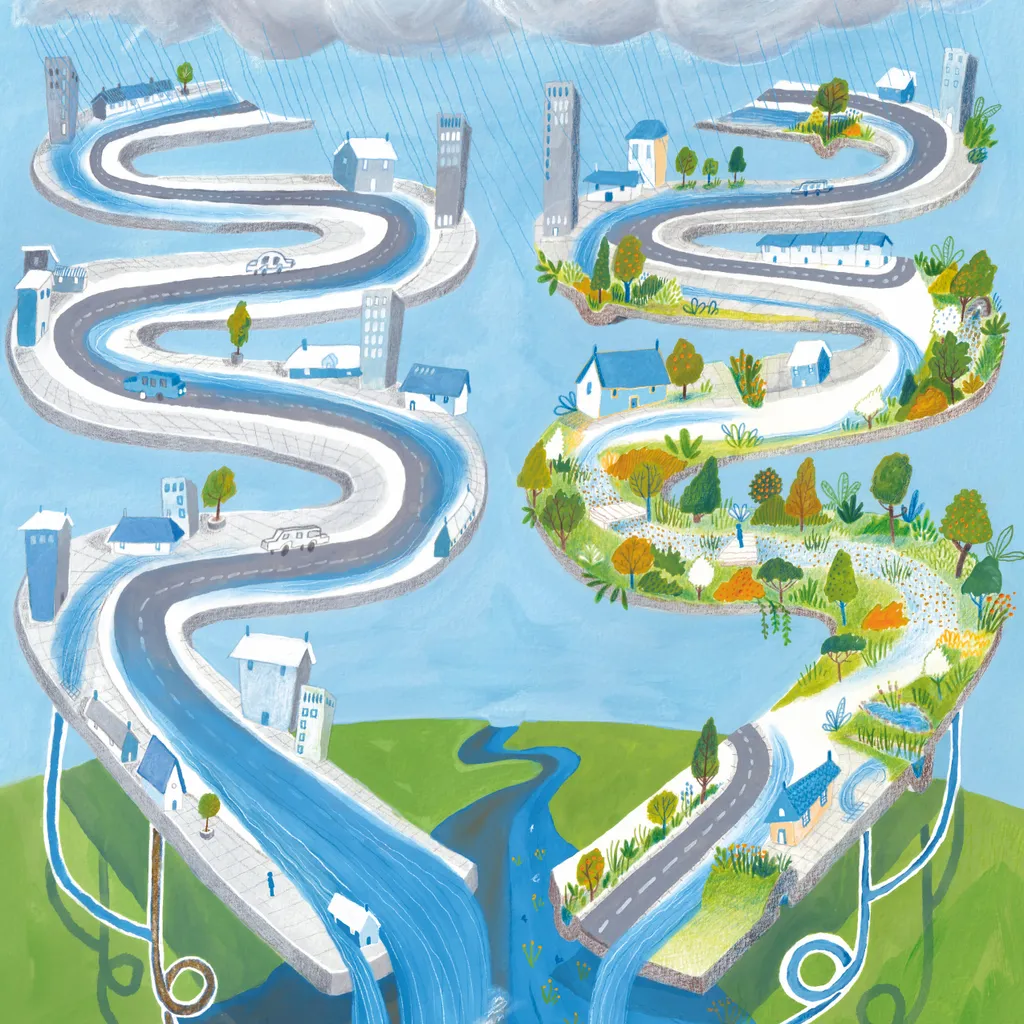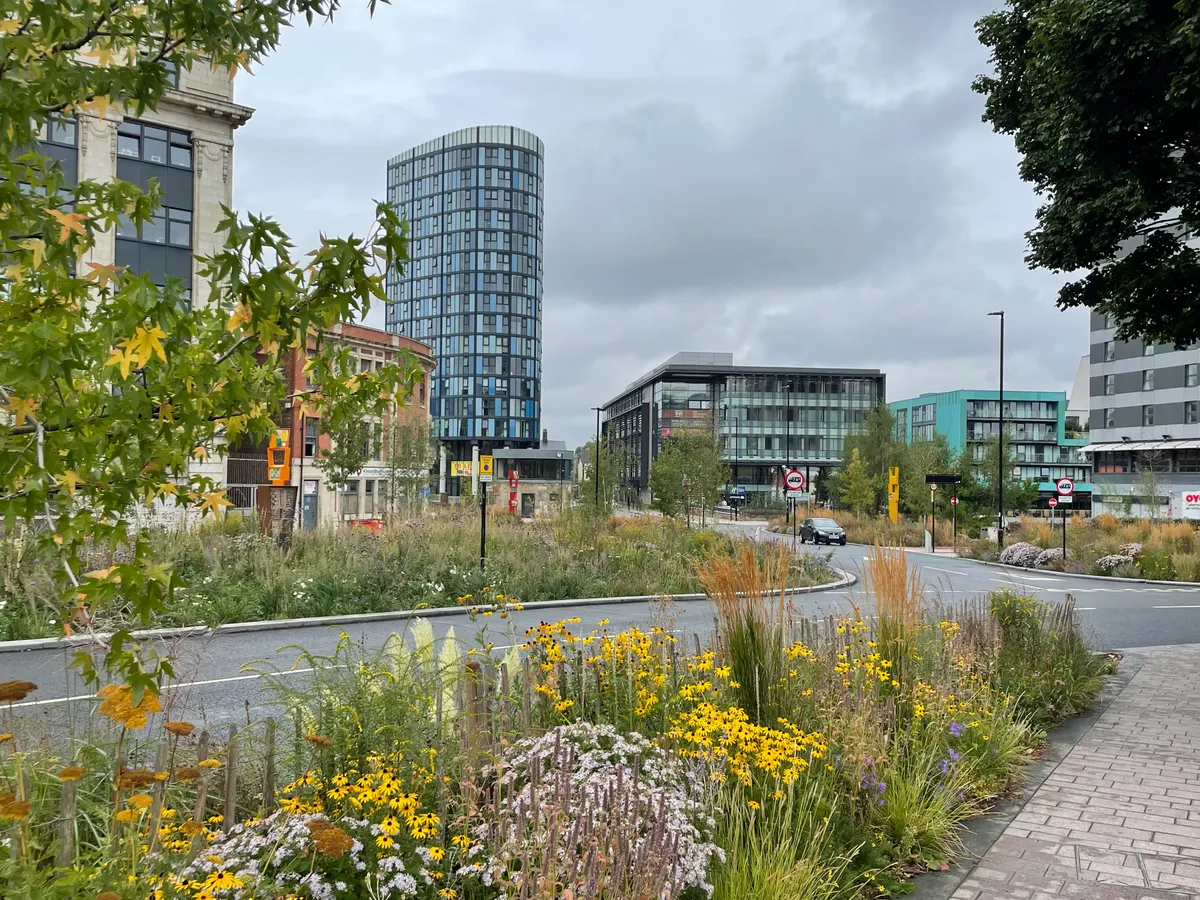So-called 'green engineering' offers nature-based solutions to many of the problems facing modern living. When it comes to mitigating the damage caused by extreme flooding events, 'SuDS', 'green infrastructure' and 'NBS' (Nature-Based Solutions) are some of the ways we can harness nature to 'slow the flow'.
It was raining when I visited Manchester, fittingly one might say, given its popular image. Fittingly, also, because I was standing in West Gorton Community Park, which includes a lovely rain garden.
What is a rain garden?
A rain garden is a sunken area filled with water-loving plants where rain is channelled and left to soak away slowly, rather than bouncing off the roads and pavements then hitting the grids all at once, swamping the already overburdened sewerage system.
The rain garden is one of a number of features in the park designed to manage storm water and help prevent flooding in an area that is prone to it. These other features include swales (imagine ditches planted up with vegetation), timber dams, permeable paving, alder trees, and a mini wildflower meadow where ox-eye daisies sway gently in the breeze.
Not that you are immediately aware that these are rainwater management features, which give it its nickname of the 'sponge park'. All you really see is a beautiful green space, an oasis of calm in the city.
In the past three to four years, you can really feel a move towards nature-based solutions
LEE PITCHER, YORKSHIRE WATER’S HEAD OF PARTNERSHIPS
Manchester City Council commissioned this award-winning park as part of a 10-year plan to regenerate the area. It is also one of the UK’s first research and demonstration project for assessing how Nature-Based Solutions can help combat climate change, and is being closely monitored by scientists at Manchester University.
None of its design concepts are difficult. You take the hard, flat surfaces of the urban environment and do your best to get rid of them. Soften them, roughen them, make them porous. Scoop out sections and fill them with water-loving plants. Then, channel the rainwater into them and let the vegetation soak it up. That water is then released slowly back into the atmosphere via transpiration in the leaves.
Given that the natural world has been doing this for years, it makes sense that these methods are called Nature-Based Solutions (NBS). Green Infrastructure is another term; SuDS another, which stands for Sustainable Drainage Systems. Snappy, huh?
Whatever you want to call it, NBS tick a lot of boxes. They take some stress off our antiquated sewerage system; their trees and plants store carbon, helping to mitigate climate change; and they create valuable wildlife habitat. They also provide the green lungs that are so important for our physical and mental wellbeing. NBS is a wonderful and simple idea.

Why aren't we using NBS already?
Mark Turner is team leader of Natural Course, a partnership from the Greater Manchester Combined Authority that aims to improve water quality. “The [green] technology has been in place for a while, so we know what can be done,” he says. “But how do we pay for it? And how do we go from funding demonstration projects to delivering neighbourhood-wide solutions? Everybody sees it as somebody else’s project.”
An insight into why green infrastructure projects have been so slow to leave the drawing board can be found on the River Wyre in Lancashire, where a £1.5m Natural Flood Management (NFM) pilot project is underway. The catalyst for the project, which will protect towns and villages along the 45km of the Wyre from flooding, was the severe storms the region experienced in 2015.
Engineers like to do grand projects with concrete and pipes, because that is how they were trained
MARK LLOYD, CEO OF THE RIVERS TRUST
“Effectively we will be delivering 70ha of NFM interventions and 39ha of woodland creation,” says Tom Myerscough, general manager of the Wyre Rivers Trust, which is co-steering the project. “Work will include the installation of ‘leaky dams’ [woody material laid to slow water flow], ponds, scrapes, river restoration, hedges and offline storage [where water is diverted from the river channel and stored in a separate area].”
This work will improve water quality as well as help prevent flooding. It will create superb habitat for wildlife, as well as making beautiful places. The work itself is relatively straightforward – the innovation has been in how to finance it and how to get people to accept new ways of doing things, which took two years.
“A lot of things are run by engineers, and engineers are keen to keep doing grand projects with concrete and pipes,” says Mark Lloyd, CEO of the Rivers Trust. “There is also a lag within our institutions, in that you get innovative thinking, but there is a resistance to adopt ideas wholesale because it feels risky.”

Can NBS be used in our homes?
The principle of ‘slowing the flow’ applies as much on a household level as it does on a landscape scale. Peter Melville-Shreeve of Exeter University’s engineering department researches rainwater management systems for homes, focusing on the more mundane weather events that occur perhaps multiple times a year, overloading the sewerage system and leading to Combined Sewerage Overflows (CSOs) discharging into rivers.
We have in this country a combined sewerage system, where waste from toilets ends up in the same pipes as rainwater. If there is too much volume in the system (due to heavy rain, for instance), then the excess escapes through the ‘valve’ of the CSO into our rivers, much to the detriment of wildlife, not to mention our enjoyment of what should be a beautiful natural resource.
One solution would be to make the existing underground storage tanks bigger (so-called ‘grey infrastructure’, meaning hard engineering); another is to use more natural, above-ground solutions to ‘slow the flow’ of the storm water and prevent that sudden increase in volume. And the impact of flow can be dramatic: during a heavy storm, a 6m² patio will generate a similar volume of rainwater to the foul outflow of 100 houses in a day.
Melville-Shreeve has been developing an above-ground solution: water tanks attached to gutters, which slow the flow of rainwater into the drainage system during heavy rainfall and reuse that water to, for instance, flush toilets. These raintanks are ‘leaky’ (like a bucket with a hole), so they are not already full when needed to hold back water during a storm. They also have ‘smart’ controls, so that the capacity for a coming storm can automatically be created by opening a valve. It isn’t easy to sell a big bucket with a small hole in it, but that is essentially what Melville-Shreeve has done.
One senior water company executive told me of a pilot project where 55 such water tanks had been deployed to houses, leading to a 75 per cent reduction in CSO discharges into the local river. Melville-Shreeve says that his own generic computer modelling makes this figure seem entirely feasible.
Given that it is written into the Environment Act that water companies must reduce CSO discharges, Melville-Shreeve thinks we can expect much more emphasis on managing rainwater on the domestic scale over the coming years, with our own smart water tanks and rain gardens, for instance. "It is the shift that has to happen – and I believe is going to happen," he says.

How are cities investing in NBS?
It often requires a catastrophic event to change the way we do things. In Yorkshire, the 2007 floods resulted in the groundbreaking Grey to Green infrastructure project. In Hull, the same storm, which closed 91 out of 98 schools and forced 8,000 people to evacuate their homes, triggered an increased investment in ‘grey’ infrastructure, but with an emphasis on ‘green’ solutions, too.

Grey to Green, Sheffield city centre
Sheffield sits immediately below the Dark Peak and Yorkshire Moors and is highly vulnerable to flooding. Following a series of catastrophic floods, the city has become an exemplar of how an urban space can be re-imagined with green infrastructure and innovative flood- mitigation design.
The Grey to Green project in the city centre not only looks beautiful, with seating areas among planted-up beds, but acts as a sophisticated sustainable drainage and filtration system.
The plant beds are, in fact, reservoirs to hold back the flow of storm or flood water, and the plant roots filter the water before it is returned to the river.
According to Grey to Green, “24,000 bathtubs’ worth of water is prevented from entering Sheffield’s sewage treatment works each year.” It is a lovely place to sit and eat your sandwiches when the sun is shining – a city centre as glorious as a summer meadow, beside the glinting River Don.
Lee Pitcher is Yorkshire Water’s head of partnerships and general manager of Living with Water – a partnership that aims to reduce surface-water flood risk using innovative NBS.
“The difficulty is, for 50-plus years, engineers have gone through an education programme that has been focused on grey engineering,” says Pitcher. “So the first thing is: where do you get the different thinking and cultural change among employers and in schools and colleges to encourage green solutions?”
Living with Water encourages nature-based thinking in primary school children through to PhD students. The biggest culture shock for our current engineers is that these strategies often start with people.
“It’s not like you turn up, build a big tank underground, cause disruption for three weeks and then move away – you are working and co-creating with that community,” says Pitcher. “But in the past three to four years, the impetus has really changed, you can feel a move towards more NBS”.
Liz Sharp is leading a multi-disciplinary team at Sheffield University that is working with communities in Hull. The MAGIC project is researching how best to introduce SuDS (Sustainable Drainage Systems) and green infrastructure into communities, and its effectiveness. Traditionally, water companies communicate with bill-payers at a household level. Sharp and her team are investigating a ‘building-based’ approach, where key buildings, such as schools and health centres, are targeted. Their communities of users then come away enthused with nature-based ideas.
MAGIC has been instrumental in setting up a local cooperative that specialises in making and fitting SuDS devices, such as planters, that have reservoirs to hold back water during a storm. They look beautiful when planted up, as well as cleverly serving as green infrastructure.
Interestingly, Sharp’s research shows that reminding people of past flood events is not a good motivator. Instead, the emphasis is on the beauty and the wildlife these installations can attract.
NBS are not designed to compensate for inadequate investment in our grey infrastructure, but would play a large part in any ‘perfect’ system, with associated benefits for climate change, wildlife and our wellbeing.
As Mark Lloyd of the Rivers Trust says: “Where there is water, there is life. Slowing the flow not only deals with the problem, it creates nature. If there is water around, you can create fantastic wetland habitats – and we have lost 90-95 per cent of our wetlands in this country. Recreating them would be a massive boon for biodiversity.”
Main image: Rain garden illustration by
